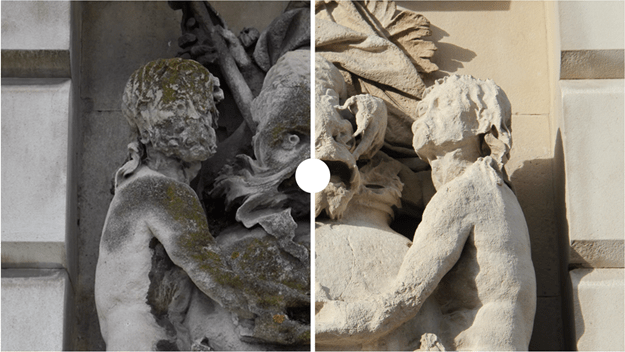Somerset House restoration, MODUS

How do you deep clean one of London’s landmark buildings, which has a packed diary of events, with the least disruption possible?
By Gela Pertusini, MODUS
In terms of grandeur, few buildings in London can rival Somerset House, the palatial and Palladian home of the artworks of the Courtauld Institute. Sitting on the north bank of the Thames, opposite the National Theatre, it was built on the site of the Duke of Somerset’s Tudor mansion which later became the official residence of several of the Stuart monarchs’ wives before being rebuilt entirely in the late 18th century to house the Royal Academy, Royal Society and assorted government offices.
On a sunny summer’s day, its Portland stone façade gleams with an almost unnatural whiteness in a city far better known for its muted browns and greys. A quick glance at Somerset House’s lower level, which runs next to a busy road carrying traffic along the riverside, tells you that white is not the building’s customary colour but is due to a very deep clean. The work was carried out by the British restoration specialists Thomann-Hanry® using a technique that the company has developed to clean historic stonework and elevations, called “façade gommage®” – from the French for rub or exfoliate. The method involves raising a cabin – about the size of a transit van – on the arm of a cherry picker to the required level and directing a hose at the area that needs work.
So far, so normal but, rather than water or the grit used more commonly, the gommage system uses a very fine, but sharp-edged, powder made from aluminium silicate (a waste product from the manufacture of aluminium) which is delivered at low pressure to the stonework and gently removes the built-up grime.
“It’s akin to mineral talc,” says Mark Styles, Thomann-Hanry’s managing director. “If you dropped a handful in a room, it would waft and spread out rather than fall to the floor so it’s incredibly light compared to what might be used in [other] cleaning processes.”
The raised cabin contains large fans that create a vacuum so that all the loosened dirt and the aluminium silicate powder is then sucked back into it and passed through a water curtain, which turns the waste into a slurry. This is then run back to ground level and filtered to separate out the powder and dirt which is eventually used for aggregate while the water is recycled.
Its absence of chemicals, reuse of water and repurposing and recycling of an industrial by-product give the gommage method impeccable eco-credentials which certainly make it attractive. But, perhaps a bigger draw is that its lack of scaffolding gives it relative nimbleness.
